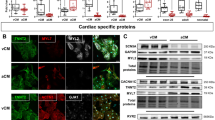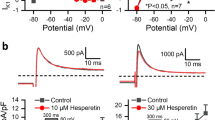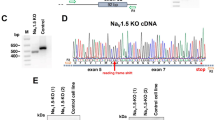Abstract
Aim:
Voltage-gated sodium channels composed of a pore-forming α subunit and auxiliary β subunits are responsible for the upstroke of the action potential in cardiac myocytes. The pore-forming subunit of the cardiac sodium channel Nav1.5, which is encoded by SCN5A, is the main ion channel that conducts the voltage-gated cardiac sodium current (INa) in cardiac cells. The current study sought to investigate the inhibitory effects of hesperetin on human cardiac Nav1.5 channels stably expressed in human embryonic kidney 293 (HEK 293) cells and on the voltage-gated cardiac sodium current (INa) in human atrial myocytes.
Methods:
The effects of hesperetin on human cardiac Nav1.5 channels expressed in HEK 293 cells and on cardiac Na+ currents in human atrial myocytes were examined through whole-cell patch-clamp techniques.
Results:
Nav1.5 currents were potently and reversibly suppressed in a concentration- and voltage-dependent manner by hesperetin, which exhibited an IC50 of 62.99 μmol/L. Hesperetin significantly and negatively shifted the voltage-dependent activation and inactivation curves. Hesperetin also markedly decelerated Nav1.5 current inactivation and slowed the recovery from Nav1.5 channel inactivation. The hesperetin-dependent blockage of Nav1.5 currents was frequency-dependent. Hesperetin also potently and reversibly inhibited Na+ current (INa) in human atrial myocytes, consistently with its effects on Nav1.5 currents in HEK 293 cells.
Conclusion:
Hesperetin is a potent inhibitor of INa in human atrial myocytes and Nav1.5 channels expressed in human embryonic kidney 293 cells. Hesperetin probably functions by blocking the open state and the inactivated state of these channels.
Similar content being viewed by others
Log in or create a free account to read this content
Gain free access to this article, as well as selected content from this journal and more on nature.com
or
References
Kleber AG, Rudy Y . Basic mechanisms of cardiac impulse propagation and associated arrhythmias. Physiol Rev 2004; 84: 431–88.
Catterall WA, Goldin AL, Waxman SG . International Union of Pharmacology. XLVII. Nomenclature and structure-function relationships of voltage-gated sodium channels. Pharmacol Rev 2005; 57: 397–409.
Catterall WA . From ionic currents to molecular mechanisms: the structure and function of voltage-gated sodium channels. Neuron 2000; 26: 13–25.
Goldin AL . Resurgence of sodium channel research. Annu Rev Physiol 2001; 63: 871–94.
Han Z, Jiang Y, Xiao F, Cao K, Wang DW . The effects of A-803467 on cardiac Nav1.5 channels. Eur J Pharmacol 2015; 754: 52–60.
Bennett PB, Yazawa K, Makita N . George AL Jr. Molecular mechanism for an inherited cardiac arrhythmia. Nature 1995; 376: 683–5.
Priori SG, Wilde AA, Horie M, Cho Y, Behr ER, Berul C, et al. HRS/EHRA/APHRS expert consensus statement on the diagnosis and management of patients with inherited primary arrhythmia syndromes: document endorsed by HRS, EHRA, and APHRS in May 2013 and by ACCF, AHA, PACES, and AEPC in June 2013. Heart Rhythm 2013; 10: 1932–63.
Bolli R . The new circulation research: a manifesto. Circ Res 2010; 106: 216–26.
Ravens U, Poulet C, Wettwer E, Knaut M . Atrial selectivity of antiarrhythmic drugs. J Physiol 2013; 591: 4087–97.
Erlund I, Meririnne E, Alfthan G, Aro A . Plasma kinetics and urinary excretion of the flavanones naringenin and hesperetin in humans after ingestion of orange juice and grapefruit juice. J Nutr 2001; 131: 235–41.
Knekt P, Kumpulainen J, Jarvinen R, Rissanen H, Heliovaara M, Reunanen A, et al. Flavonoid intake and risk of chronic diseases. Am J Clin Nutr 2002; 76: 560–8.
Calderone V, Chericoni S, Martinelli C, Testai L, Nardi A, Morelli I, et al. Vasorelaxing effects of flavonoids: investigation on the possible involvement of potassium channels. Naunyn-Schmiedeberg's Arch Pharmacol 2004; 370: 290–8.
Kumar B, Gupta SK, Srinivasan BP, Nag TC, Srivastava S, Saxena R, et al. Hesperetin rescues retinal oxidative stress, neuroinflammation and apoptosis in diabetic rats. Microvasc Res 2013; 87: 65–74.
Cho J . Antioxidant and neuroprotective effects of hesperidin and its aglycone hesperetin. Arch Pharm Res 2006; 29: 699–706.
Emim JA, Oliveira AB, Lapa AJ . Pharmacological evaluation of the anti-inflammatory activity of a citrus bioflavonoid, hesperidin, and the isoflavonoids, duartin and claussequinone, in rats and mice. J Pharm Pharmacol 1994; 46: 118–22.
Garg A, Garg S, Zaneveld LJ, Singla AK . Chemistry and pharmacology of the Citrus bioflavonoid hesperidin. Phytother Res 2001; 15: 655–69.
Scholz EP, Zitron E, Kiesecker C, Thomas D, Kathofer S, Kreuzer J, et al. Orange flavonoid hesperetin modulates cardiac hERG potassium channel via binding to amino acid F656. Nutr Metab Cardiovasc Dis 2007; 17: 666–75.
Wang H, Wang HF, Wang C, Chen YF, Ma R, Xiang JZ, et al. Inhibitory effects of hesperetin on Kv1.5 potassium channels stably expressed in HEK 293 cells and ultra-rapid delayed rectifier K+current in human atrial myocytes. Eur J Pharmacol 2016; 789: 98–108.
Li GR, Wang HB, Qin GW, Jin MW, Tang Q, Sun HY, et al. Acacetin, a natural flavone, selectively inhibits human atrial repolarization potassium currents and prevents atrial fibrillation in dogs. Circulation 2008; 117: 2449–57.
Benjamin EJ, Wolf PA, D'Agostino RB, Silbershatz H, Kannel WB, Levy D . Impact of atrial fibrillation on the risk of death: the Framingham Heart Study. Circulation 1998; 98: 946–52.
Duffy SJ . Keaney JF Jr, Holbrook M, Gokce N, Swerdloff PL, Frei B, et al. Short- and long-term black tea consumption reverses endothelial dysfunction in patients with coronary artery disease. Circulation 2001; 104: 151–6.
Takumi H, Mukai R, Ishiduka S, Kometani T, Terao J . Tissue distribution of hesperetin in rats after a dietary intake. Biosci Biotechnol Biochem 2011; 75: 1608–10.
Sokolov S, Peters CH, Rajamani S, Ruben PC . Proton-dependent inhibition of the cardiac sodium channel Nav1.5 by ranolazine. Front Pharmacol 2013; 4: 78.
Pless SA, Galpin JD, Frankel A, Ahern CA . Molecular basis for class Ib anti-arrhythmic inhibition of cardiac sodium channels. Nat Commun 2011; 2: 351.
Wang Y, Mi J, Lu K, Lu Y, Wang K . Comparison of gating properties and use-dependent block of Nav1.5 and Nav1.7 channels by anti-arrhythmics mexiletine and lidocaine. PLoS One 2015; 10: e0128653.
Wang Z, Fermini B, Nattel S . Effects of flecainide, quinidine, and 4-aminopyridine on transient outward and ultrarapid delayed rectifier currents in human atrial myocytes. J Pharmacol Exp Ther 1995; 272: 184–96.
Arechiga IA, Barrio-Echavarria GF, Rodriguez-Menchaca AA, Moreno-Galindo EG, Decher N, Tristani-Firouzi M, et al. Kv1.5 open channel block by the antiarrhythmic drug disopyramide: molecular determinants of block. J Pharmacol Sci 2008; 108: 49–55.
Perchenet L, Clement-Chomienne O . Characterization of mibefradil block of the human heart delayed rectifier hKv1.5. J Pharmacol Exp Ther 2000; 295: 771–8.
Wang C, Chen YF, Quan XQ, Wang H, Zhang R, Xiao JH, et al. Effects of neferine on Kv4.3 channels expressed in HEK293 cells and ex vivo electrophysiology of rabbit hearts. Acta Pharmacol Sin 2015; 36: 1451–61.
Tang Q, Jin MW, Xiang JZ, Dong MQ, Sun HY, Lau CP, et al. The membrane permeable calcium chelator BAPTA-AM directly blocks human ether a-go-go-related gene potassium channels stably expressed in HEK 293 cells. Biochem Pharmacol 2007; 74: 1596–607.
Jeong I, Choi BH, Yoon SH, Hahn SJ . Carvedilol blocks the cloned cardiac Kv1.5 channels in a beta-adrenergic receptor-independent manner. Biochem Pharmacol 2012; 83: 497–505.
Jeong I, Choi BH, Hahn SJ . Pergolide block of the cloned Kv1.5 potassium channels. Naunyn-Schmiedeberg's Arch Pharmacol 2013; 386: 125–33.
Zimmer T, Haufe V, Blechschmidt S . Voltage-gated sodium channels in the mammalian heart. Glob Cardiol Sci Practice 2014; 2014: 449–63.
Kaufmann SG, Westenbroek RE, Maass AH, Lange V, Renner A, Wischmeyer E, et al. Distribution and function of sodium channel subtypes in human atrial myocardium. J Mol Cell Cardiol 2013; 61: 133–41.
Smith RD, Goldin AL . Functional analysis of the rat I sodium channel in xenopus oocytes. J Neurosci 1998; 18: 811–20.
Viswanathan PC, Balser JR . Inherited sodium channelopathies: a continuum of channel dysfunction. Trends Cardiovasc Med 2004; 14: 28–35.
Stokoe KS, Thomas G, Goddard CA, Colledge WH, Grace AA, Huang CL . Effects of flecainide and quinidine on arrhythmogenic properties of Scn5a+/Delta murine hearts modelling long QT syndrome 3. J Physiol 2007; 578: 69–84.
Wang GK, Wang SY . Block of human cardiac sodium channels by lacosamide: evidence for slow drug binding along the activation pathway. Mol Pharmacol 2014; 85: 692–702.
Acknowledgements
We thank Dr Gui-rong LI (University of Hong Kong) for providing the HEK 293 cells stably expressing Nav1.5 channels.
Author information
Authors and Affiliations
Corresponding author
Rights and permissions
About this article
Cite this article
Wang, H., Wang, Hf., Zhang, H. et al. Inhibitory effects of hesperetin on Nav1.5 channels stably expressed in HEK 293 cells and on the voltage-gated cardiac sodium current in human atrial myocytes. Acta Pharmacol Sin 37, 1563–1573 (2016). https://doi.org/10.1038/aps.2016.97
Received:
Accepted:
Published:
Issue date:
DOI: https://doi.org/10.1038/aps.2016.97



